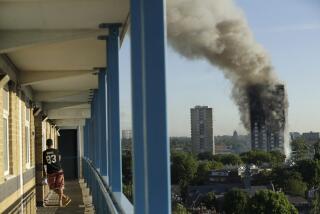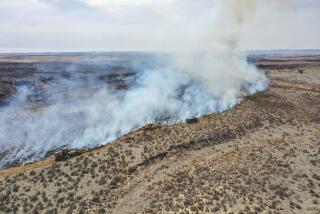Chronic Flaws Blamed for Fall of Texas Bonfire Pile
- Share via
COLLEGE STATION, Texas — Technical and organizational flaws, years in the making, led to the Texas A&M; bonfire pile collapse last year that killed 12 students, investigators said in a sober, sometimes scathing presentation Tuesday.
“A complex and dangerous structure was allowed to be built without adequate physical or engineering control,” said Houston construction executive Leo Linbeck, who chaired the five-member commission appointed by the university.
For the record:
12:00 a.m. May 5, 2000 For the Record
Los Angeles Times Friday May 5, 2000 Home Edition Part A Part A Page 3 Metro Desk 1 inches; 33 words Type of Material: Correction
Bonfire--Because of an editing error, a Times story Wednesday misstated the time it took to build the Texas A&M; bonfire that collapsed last year. It took the students about 100,000 man-hours to erect the structure, not 100,000 hours.
Speaking to a hushed arena full of students and school officials, the panel also outlined safety violations, from drinking to hazing on the bonfire site, but deemed them unrelated to the pile’s collapse.
Structurally, the disaster’s cause was internal stress on the bonfire stack from faulty log placement and lack of proper containment of the logs with wires and cables. Another flaw, investigators said, was the absence of constraining cables wrapped around the bottom tier of timbers.
But, the panel said, these physical dysfunctions were “driven by an organizational failure, which had its roots in decisions and actions by both students and university officials over many years.”
The wooden ziggurat, a 90-year-old tradition that started with a 1909 debris pile, toppled on Nov. 18, crushing 12 students and injuring more than two dozen more. In the aftermath, a university that prides itself on unity and custom has had to reassess one of its dearest symbols, a ritual that precedes the annual football game against archrival Texas.
The bonfire stack was too big, dangerous and complex for its student-led builders, the panel said. Using slides, charts and the latest management-consulting jargon, the commission outlined an orally based, tradition-bound procedure that might have come out of another era.
A key flaw, the group said, was the lack of blueprints for the four-story structure built over about 100,000 hours. Despite many students’ belief that the bonfire structure was identically built from year to year, it actually differed each time.
And although the university responded to discrete safety issues, such as a 1957 collapse, officials never perceived these as part of a systemic problem.
“The university,” the panelists reported, “has a culture that instills bias and tunnel vision in decision making. No credible source ever suspected or thought to inquire about structural safety. No one in the administration ever interpreted ongoing behavioral problems as indications that safe bonfire design and construction was beyond the capabilities of student leaders.”
The investigators also wrote that the A&M; community’s responses to past bonfire criticism showed an “illusion of invulnerability,” “self-censorship” and “rationalization.”
Though the panel didn’t make recommendations, Linbeck remarked after the presentation that he believes the bonfire can be viable in the future under the right circumstances.
A&M; President Ray Bowen said he accepted the report without disagreement and would need about six weeks to decide if the bonfire tradition should live on.
“I have not made up my mind,” Bowen said. “If I allow my heart to make the decision, we would continue bonfire. My heart will not make the decision. My brain needs to make the decision. “
Though some A&M; community members oppose the bonfire, many have passionately defended it since the disaster, including many family members of the victims. Watching from the arena stands Tuesday, students dressed in university T-shirts or cadet uniforms cheered at any remarks that seemed to suggest the bonfire would continue.
Sophomore Tara Wright, however, said she was taken aback at the litany of safety and organizational infractions. “You kind of wanted one reason--and they can’t pinpoint a reason. That was surprising to me. It becomes such an idol, and they worship it. I don’t like to see that.”
(BEGIN TEXT OF INFOBOX / INFOGRAPHIC)
Bonfire Accident Report
The collapse of bonfire logs at Texas A&M; University that killed 12 people last November was caused by poor design and weak oversight of the project, investigators said.
*
Source: Special Commission on the 1999 Texas A&M;
Bonfire Final Report; researched by JULIE SHEER / Los Angeles Times
More to Read
Sign up for Essential California
The most important California stories and recommendations in your inbox every morning.
You may occasionally receive promotional content from the Los Angeles Times.













